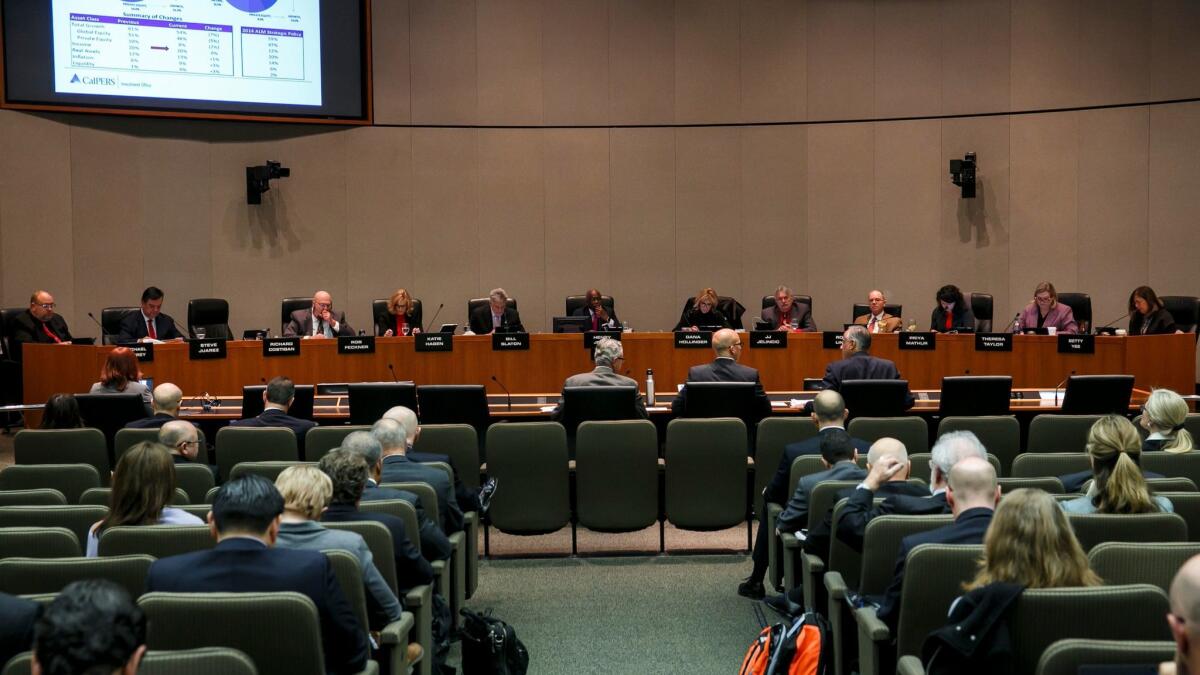Republicans are fighting to reduce union influence over California’s biggest public employee pension fund

- Share via
Reporting from Sacramento — A quarter of a century after a bitter political fight for control of California’s largest public employee pension fund, a new effort by Republicans in the state Capitol seeks to again dilute the influence of public employee unions by reshaping the agency’s board of directors.
The bill, introduced by Assemblyman Travis Allen (R-Huntington Beach), would add two members to the board that oversees the California Public Employees’ Retirement System, CalPERS. It would also reshape the qualifications for three of the existing 13 positions on the board, either by requiring additional expertise or by limiting participation by those with a connection to public employee unions.
“I want to make sure that the future of California’s pensions is in the best hands possible,” Allen said. “I think it makes a ton of sense for the best practices of the private sector to come into the public sector.”
The makeup of the CalPERS board membership was enshrined in the California Constitution in 1992 by voters. Of its 13 directors, six are chosen by employees who earn pension benefits. Two are directly appointed by the governor.
Allen’s bill would give Gov. Jerry Brown and his successors the power to appoint two more CalPERS directors, for a total of four positions. That, plus two existing positions over which the governor has influence, could either match or surpass the power exerted by public employee unions.
“I think the unions absolutely belong at the table,” Allen said. “At the same time, the chief executive of California has to ensure that promises are not made that cannot be kept.”
The bill goes a step further in changing the CalPERS board’s balance of power by also imposing new restrictions on how leaders of the Legislature choose their allotted appointment to the board. That single spot would be off-limits to any candidate with employee or public union connections, a challenge to the political alliances of most Democratic lawmakers.
Though it was unveiled Friday, the final day for bills to be introduced this year, the idea of a pension board overhaul is not new in Sacramento. Brown himself pitched a similar idea in 2011, suggesting at the time in a written statement that “the lack of independence and financial sophistication on public retirement boards has contributed to unaffordable pension benefit increases.”
A spokeswoman for Brown declined to comment on the new bill, citing the governor’s general policy of refraining from weighing in on pending legislation. A CalPERS spokesman said the agency hadn’t yet reviewed the bill.
Though the idea for the bill has been floated before, its fate in the statehouse could be rocky given it requires support not only from legislative Democrats but also from a majority of California voters in next June’s statewide primary.
Nonetheless, the proposal is perhaps the clearest sign of the effort in recent months to forcefully push CalPERS to adopt a more fiscally conservative approach. That culminated in the board’s decision last December to lower CalPERS’ official investment assumptions by a half-percentage point over a three-year period.
That change means more long-term pension costs will be borne by taxpayers — through government contributions — and by employees, who must set aside additional dollars from their paychecks. The state budget will see a higher CalPERS contribution in the fiscal year that begins this summer, while local governments and school districts will get an extra year to prepare.
Read more: California’s pension gap and how the costs keep climbing »
A CalPERS report released last month estimated the $302-billion fund, the nation’s largest, has only 69% of the assets it needs to pay existing retirement promises for government employees. It was concerns over that unfunded liability that sparked recent action to shift more of the burden away from investment profits.
Dave Low, executive director of the California School Employees Assn. and a vocal critic of that action, said Wednesday that Allen’s legislation raises the same red flags as the 1991 effort by former Gov. Pete Wilson to wrest away control of CalPERS investment decisions.
“I think that this would give the governor outsized influence,” Low said. “The unions would prefer the board the way it exists now.”
Low said that the fight more than two decades ago laid bare the reality that any governor, if given the power, could twist arms on the CalPERS board to make long-term investment assumptions based on political goals. He said Brown’s recent efforts, including attempts to privately lobby individual CalPERS directors, make clear that a governor already has enormous power.
“The governor’s been able to flex a lot of muscle as it is,” Low said.
Follow @johnmyers on Twitter, sign up for our daily Essential Politics newsletter and listen to the weekly California Politics Podcast
ALSO:
Political Road Map: The long, cold winter for California’s pension funds is coming
UPDATES:
5 p.m. This article was updated with comment from Assemblyman Travis Allen (R-Huntington Beach).
This article was originally published at 12:05 a.m.
More to Read
Get the L.A. Times Politics newsletter
Deeply reported insights into legislation, politics and policy from Sacramento, Washington and beyond. In your inbox twice per week.
You may occasionally receive promotional content from the Los Angeles Times.











